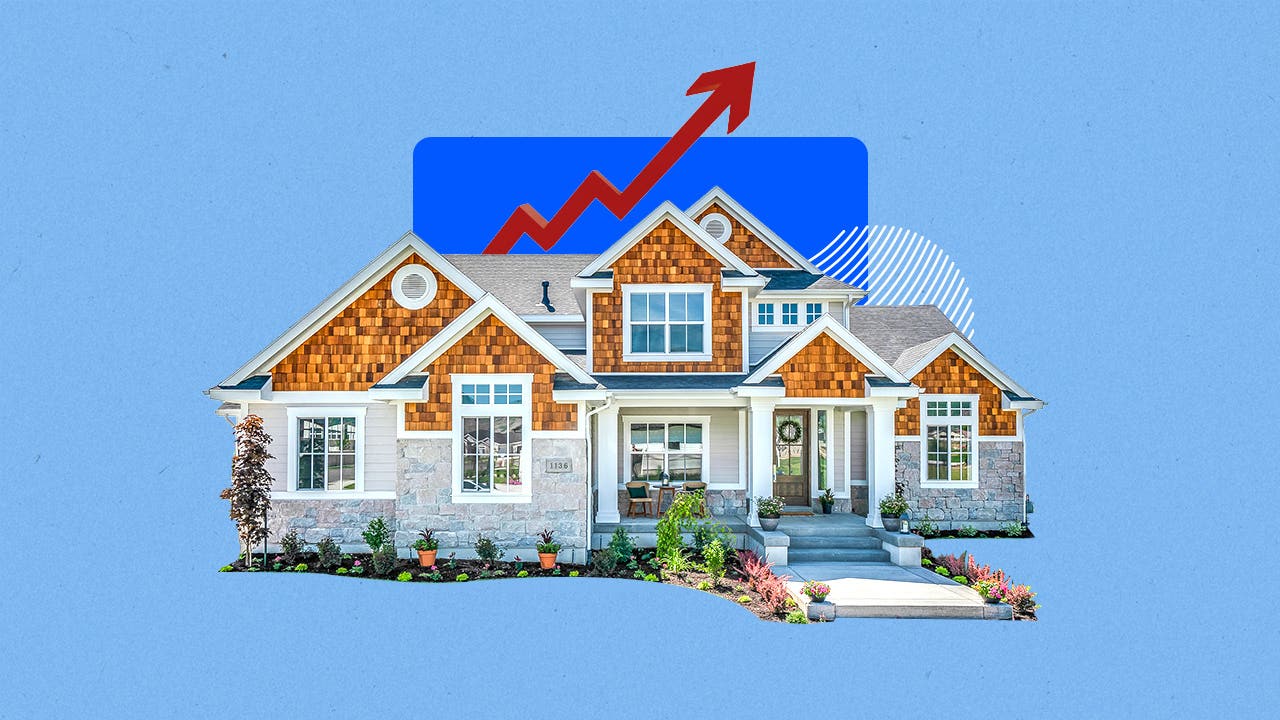Mortgage rate forecast for February 2023: Will the groundhog see the shadow of January rates?

The Bankrate promise
At Bankrate we strive to help you make smarter financial decisions. While we adhere to strict , this post may contain references to products from our partners. Here's an explanation for .
Come February, Americans anticipate the activity of Punxsutawney Phil, the climate-forecasting rodent whose shadow will signal if winter will persist longer or be shorter.
But weather isn’t the only thing we’re eager to get an expert forecast on right now. Many of us also want to know where mortgage rates will land in the second month of 2023, all the better to guide our decisions on purchasing or refinancing a home.
Here’s a silver lining among these overcast days of snow, ice and frigid temperatures: Freddie Mac reports that mortgage rates continue to dip. The benchmark 30-year fixed-rate mortgage is averaging 6.13 percent at the time of this writing, up 2.58 percent from a year ago but down from its 7.08 percent high last autumn. And the Mortgage Bankers Association (MBA) reports that for the week ending Jan. 20, mortgage applications jumped 7.0 percent over the week prior.
How will rates shake out in February? When will it become more affordable to finance a home purchase? Will Punxsutawney Phil see his shadow? For answers to all (except for the latter), we turned to a handful of pros who regularly forecast mortgage rates.
Rates in the low 6 percent range
After polling industry insiders, the takeaway is pretty clear — if undramatic: Mortgage rates likely won’t move significantly over the next few weeks. At best, they’ll trend downward, like a drifting snowflake.
“Unless the Fed unexpectedly raises the Fed Funds rate dramatically at its next meeting, or we get a surprisingly bad inflation report, it seems most likely that mortgage rates will plateau or perhaps decline slightly,” says Rick Sharga, executive vice president of Market Intelligence for ATTOM. He expects rates to average 6.0 percent to 6.25 percent for the 30-year mortgage and 5.25 percent to 5.50 percent for the 15-year mortgage loan in February.
Nadia Evangelou, senior economist and director of Real Estate Research for the National Association of Realtors, expects much of the same for the second month of the year. “Mortgage rates will continue their downward track in February,” she forecasts. “With lower inflation, smaller interest rate hikes by the Federal Reserve, and growing recession fears, the rate on a 30-year fixed mortgage will average 6.2 percent in February versus 5.5 percent for a 15-year fixed-rate mortgage.”
Bear in mind that mortgage rates, in general, have been declining slightly over the past few weeks and are now about a full point lower than when they peaked at over 7 percent back in November 2022.
“This has probably been due to several consecutive positive reports on inflation and the expectation that the Federal Reserve may be able to ease off on its quantitative tightening in the near future,” Sharga adds.
Bankrate chief financial analyst Greg McBride envisions a slightly wider rate spread this month.
“I expect the average 30-year fixed mortgage rate between 6 percent to 6.4 percent and the average 15-year fixed mortgage rate between 5.2 percent and 5.5 percent during February,” he says. “This is a wider range because I expect more volatility as we digest a Fed meeting (set for Feb. 1), incoming economic data, and the Russia-Ukraine war hits the one-year mark.”
Mortgage rates will likely remain above 6 percent in February but should gradually decline as the year progresses, believes Selma Hepp, deputy chief economist for CoreLogic. “One of the reasons for this prediction is a potentially clearer outlook for the U.S. economy,” she notes. “Based on recent economic data, while the U.S. economy is slowing more experts believe we are heading for a shallow recession with a soft landing.”
The Mortgage Bankers Association also forecasts a slightly more affordable rate climate in the near term, predicting the 30-year fixed-rate mortgage to average 6.2 percent in the first quarter of the year versus 6.4 percent predicted by Fannie Mae.
X-factors to fathom
Of course, these rate prognostications are subject to change, based on fluctuating conditions and wild cards that could send borrowing costs higher or lower than expected.
“Economic data suggest that the economy is moving in a direction expected by the Federal Reserve, but many uncertainties remain,” cautions Hepp. “At this point, the political dysfunction and dealings around the debt ceiling may have a negative impact on both Treasuries and mortgage rates if Congress doesn’t reach a consensus over increasing the debt ceiling.”
It’s always smart to expect the unexpected when it comes to factors that can impact rates. Sharga reminds readers that no one could have anticipated a global pandemic, the fallout from overly aggressive government stimulus programs, or the equally unprecedented actions by the Federal Reserve to combat the rampant inflation that those two events caused.
While inflation is still around, hovering at 6.5 percent, the worst may be over: the Consumer Price Index (CPI) actually fell 0.1 percent in December 2022. Nevertheless, this is the first time after nearly two years that inflation’s growth rate is finally lower than it was the previous year. “That means consumer prices are higher, but they are rising at a slower pace than a year ago. At the end of 2022, inflation was 6.5 percent compared to 7.0 percent in 2021,” Evangelou adds. “As a result, the Fed will likely switch to an even smaller rate hike in February. These two factors could bring mortgage rates down even further in the following months.”
“Continued slowing of the economy and any geopolitical crisis would send mortgage rates lower as well,” notes McBride.
Expect some gyration in mortgage rates as the Fed’s tough talk about higher rates counterbalances excessive optimism about inflation declining.
— Greg McBridechief financial analyst for Bankrate
How should homebuyers react?
Now that you know where the experts lean with their rate expectations, it’s time to consider your next moves.
“If you find a property you want and can afford, given today’s home prices and mortgage rates, you probably shouldn’t hesitate to move forward,” suggests Sharga. “Some markets may experience a short-term dip in home prices, but over time home prices have always risen and are likely to do so in the future.”
Remember: Owning a home typically results in more financial security in the long run than renting, and a 30-year fixed-rate loan gives a borrower more certainty regarding housing costs versus rental rates – which are likely to go up year-over-year.
“Also, if mortgage rates do come back down, you can always refinance into a lower rate in the future and actually reduce your monthly housing costs – something highly unlikely with any rental property,” Sharga says.
But avoid the impulse to act prematurely, especially if you haven’t done the math.
“Homebuyers have the ability to do proper due diligence on their purchase and shouldn’t feel the need to rush into a decision that they’re uncomfortable with or hasn’t been fully vetted,” recommends McBride. “Once the offer has been accepted, comparison-shop mortgage quotes and put in applications at three different lenders to assess which has the best deal.”
If fixed-rate loans look frightening, consider an adjustable-rate mortgage (ARM), provided you weigh the pros and cons carefully.
“ARMs have a lower rate than fixed-rate loans, and the savings may be substantial for borrowers. First-time buyers may particularly benefit from ARMs, as these buyers tend to stay in their homes for a shorter period,” Evangelou says. “However, you need to be aware that the ARM rate changes after the initial period. You should consider selling or refinancing your home before the initial period expires to avoid any significant changes in your payment.”
Timing the market is tricky
The pros agree that prospective borrowers should view mortgage predictions as educated guesses rather than certainties.
“Rate projections can inform your perspective, but the ultimate decision on when to lock your rate is going to be heavily influenced by other factors such as the expected timing of closing,” McBride says. “Mortgage rates can move suddenly as events unfold, and that event need not be something major – a minute economic data point, the tone of a speech from someone at the Fed, even sudden currency movements could be a catalyst. Just as unpredictable events happen or even predictable events happen but at unpredictable times, future projections quickly go out the window.”
Hepp seconds those sentiments.
“There are always black swans that one cannot predict, which can have a destabilizing impact on the economy and expected outlook,” she points out. “It’s important to understand what drives our predictions. In understanding that, readers can observe those drivers as well. Just remember that it’s very hard to exactly time the market to get the best rate possible.”
Related Articles



